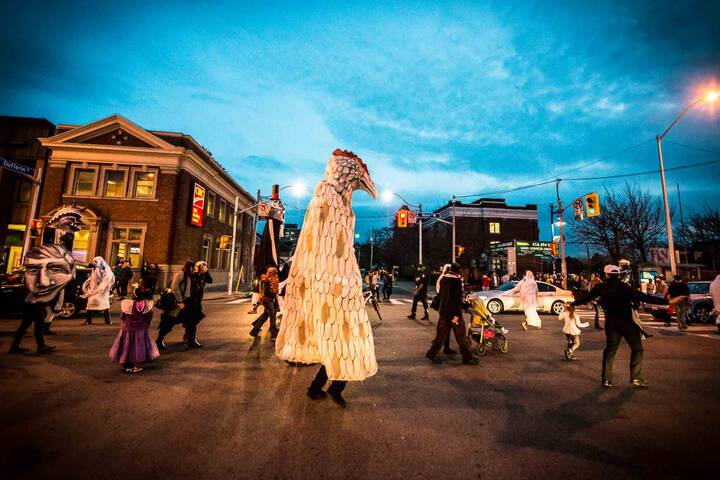
General Idea's mass media mockery at the AGO
After this spring's AbEx New York show highlighted American avant-garde painting from the 1950s and 60s, the AGO's subsequent offering, Haute Culture: General Idea gives us the next chapter in history, from a uniquely Canadian perspective: a long-due retrospective on the Canadian trio, AA Bronson, Felix Partz, and Jorge Zontal, known as General Idea, who are just as influential as Jackson Pollock and his contemporaries.
General Idea, for me, will always remind me of my first experience of art and satire: on a field trip to the National Gallery of Canada in elementary school, I saw the 1991 work "Playing Doctor", an image of the trio, striking goofy poses with stethoscopes, with colourful capsules floating above their heads. I snickered to myself, though doing so felt transgressive. Though the piece is rich with significance that I didn't grasp as a kid, it was the first time it ever occurred to me that art didn't have to be serious. It could be riotously funny or full or dark wit, it could look weird and it could make you think.
That memory has stayed with me, and I again experienced that feeling of having my mind opened on entering the exhibition. Divided thematically, Haute Culture spans the entire fourth and fifth floors at the AGO. The exhibition is curated by French independent curator FrĂŠderic Bonnet, organized in conjunction with the MusĂŠe d'Art moderne de la Ville de Paris. It's such a vast exhibition, in terms of number of works, gallery square footage, and depth of ideas, that I will still be wrapping my head around it when the exhibition finishes in January 2012.
Though it's surprising to some that audiences had to wait so long for a retrospective--General Idea disbanded nearly 20 years ago, in 1994 when Partz and Zontal died, a few months apart, from AIDS-related illnesses--the exhibition benefits from the distance in time and in culture. Bonnet, as a non-Canadian curator, is able to bring an outside perspective to the works. As for the separation in time, it lends the exhibition an air of discovery.
Bonnet's introductory text states the General Idea's oeuvre "anticipated many of today's art trends," and I couldn't agree more. From those goofy, ironic posed portraits, to multiples that blur the line between art and commerce, to the staging of elaborate performances and rituals like the Miss General Idea Pageant, the works feel extremely fresh. It's hard to tell if that's because they were ahead of their time, or because their influence is so strongly present in the work of today's hip, young, university-educated artists, or because such a comprehensive gathering of the works is unprecedented. Probably all three--and the effects are stunning.
One of the most significant aspects of General Idea's practice is that they fully embraced collectivity. "Being a trio freed us from the tyranny of the myth of the individual genius," they wrote, and indeed, they lived and worked together for 25 years. The magic number 3 is a nearly constant trope in their work, from work featuring triangles, to triptychs, to the repeated use of three poodles, to self-portraits of the trio itself.
That same posed portrait I first saw as a kid, turns out to have many iterations. Always in the stiff poses reminiscent of department-store photo studios, General Idea appeared dressed as graduates in cap and gown, or as poodles in makeup and wooly ears. This recurring playful image is especially familiar because it has been so widely mimicked and re-enacted in the recent popular wave of kitschy studio portraits of ironic-sweater-wearing hipsters.
General Idea's works cleverly parody society and societal constructs, like the video work in which the artists pose as TV hosts talking about their own artworks (Pilot, 1977). Yet the satire is always a "mix of seriousness and provocation", since there is a youthful earnestness that begins in the earlier works and never seems to fade.
Even when the AIDS crisis began to loom larger, General Idea did not lose its playfulness or humour. They began to make work about AIDS in the late 1980s but incorporated it into their existing practice of subverting society's norms and constructs--a persistent example being their AIDS logo, a direct send-up of Robert Indiana's LOVE. Though some works, such as One Month of AZT, are more sombre (and made that much more poignant by the knowledge of Partz's and Zontal's deaths), there is still something preposterous about a room full of giant pills. For General Idea, art and life were inseparable, they approached both with their characteristic wit and attitude.
Another incursion into the mass media is their magazine, FILE, an obvious parody of LIFE. Many copies are on display in cases, though I regret not being able to flip through them. The production of such publications and multiples led the group to found the artist-run centre Art Metropole in 1974 which is still alive and well near King & Tecumseth.
One of my favourite parts of the exhibition was the highlighting of General Idea's connection to Toronto. The group formed here in 1969, when the city's visual art community was just getting started--a community that they were instrumental in galvanizing. It's humbling to see the works through that lens, as it reminds me again how pioneering their practice was.
Latest Videos
Latest Videos
Join the conversation Load comments







